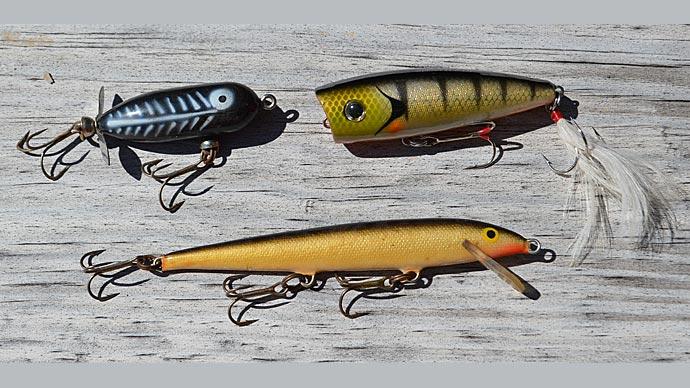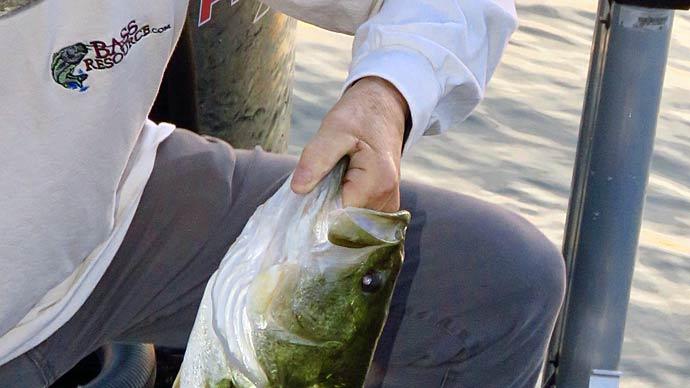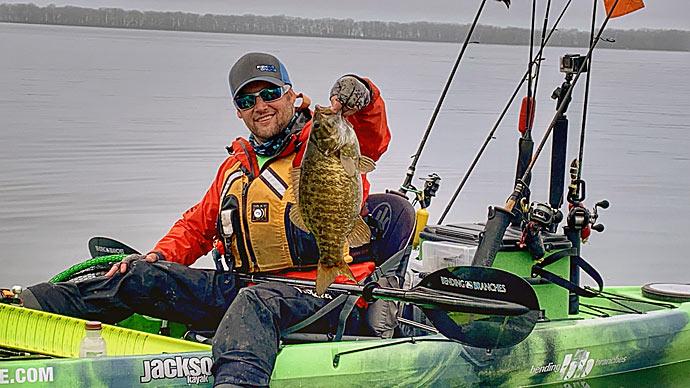
While surfers are "hanging 10" (for hanging their ten toes off the front edges of their surfboards), anglers ought to just about the same time be "hangin' six" - six hook points that are off a topwater bait of some kind in shallow water. Nothing is more exciting than catching bass shallow on topwater baits.
Seeing the splash and hearing the "whoosh" barely compare to being able, in many cases, to see the fish run for the lure you just laid on the water's surface.
When optimum cover and forage are available, many bass will remain in the shallows year-round. Bass roaming in shallow water are the easiest to find and catch if your lure selection and approach are made correctly.
Depending on weather and water conditions, the strikes that occur while fishing shallow can be even more aggressive than those encountered in deep water.
The most important aspect of fishing the shallows on top is your approach. Whether you're fishing standing timber, stumps, laydowns, rocks, grass, or flats, you will only be successful if the fish do not realize you are there. Use only your trolling motor once you have reached your fishing area. At all costs, make no noise that will spook the fish or alert them to your presence. You should turn off your big motor and troll into the area you plan to fish rather than motoring in. It will be the most important thing you do all day. Hold your boat steady and try to keep from bumping it into anything. If you drop an anchor, do so with a slow and gentle motion. The bass that live in shallow water are much more aware of activity than those that live deeper because it's right over their heads.
As important as keeping your presence secret, a gentle and quiet lure presentation is also essential. Practice at home making subtle casts that land gently. Once you acquire the skill of noiseless bait presentation, you will have a significant advantage while fishing shallow water. This isn't always easy to do with topwater lures. The art of gentle casting goes hand in hand with allowing the bait to sit motionless for as long as you can stand it. I promise you. The fish won't be able to stand it as long as you will.
Study the structure in the area you are fishing. Just because a stump looks good to you doesn't mean it will hold fish. Make a note of where and what type of structure a fish was holding on to when caught, and use the same scenario for every cast you make. For example, if a bass is holding next to a single stick-up in five feet of water, then cast to every single stick-up in the area several times before moving on. Fishing on top and just below the surface of the water in warmer months can pay off. But you must also consider the weather conditions when determining what type of cover or structure you intend to fish. For example, try fishing stick-ups and small stumps if it's an overcast day with light winds. Bass tend to move away from heavier cover to feed under overcast conditions. On sunny and bright days, they remain tighter to the cover for the darkness of any shade to hide their presence as they ambush prey.
Lure choices would include all topwater baits, but this can vary depending on your fishing area and the weather conditions. After the spawn, smaller topwaters are in order. The bass will chase small baitfish, and smaller baits will work best. In summer, you can go larger up to the largest-sized topwaters, and bass will chase them like the dickens. I've met few bass that could resist anything moving in a walk-the-dog pattern.
When you first scout an area, you'll need to figure out what area of the cover is more accessible to deep water. Even bass that live shallow year-round want deep water nearby. Next, look for creek channels and cuts. These do not have to be extremely deep, and sometimes even a slight variation on the bottom or depth can make a big difference.
When you begin to fish the area, cast beyond the target zone you want to fish. Make as quiet an entry as possible into the water with your lure. Wait as long as you can before moving the bait. A good rule of thumb is to let all the rings created by the bait's landing on the surface disappear, and then count to 10 or even 20 before just twitching it a tiny bit. Keeping the lure in the possible strike zone for as long as possible is imperative when fishing topwaters under these conditions. Too often, anglers pull their lure out of the zone too soon, and the fish may lose interest quickly if it no longer sees the lure.
During the scorching parts of summer, you don't have to leave shallow water to find and catch fish. Unfortunately, many anglers think this is the time of year to move deep, but some of the biggest bass caught during the summer months are caught shallow on various baits running on top or just under the surface.
During the hottest months of the year, bass will relate more to heavier cover on sunny days. Therefore, you'll need to make your approach as quiet as possible. Refrain from banging around in the boat or running into any of the cover you are fishing because even though the cover they are holding in may be thicker than that used on overcast days, their hearing and senses are not impaired.
Bass will seek the most comfortable and coolest places to hold during the day. Shallow water, especially under sunny conditions, will be areas with good shade. In shallow water, these target areas will appear as dark shadows. You will be looking for the largest ones in the area, not the smallest, on sunny days. However, shade is less necessary on overcast days to locate and catch fish. Again with either one, finding shallow water with deeper water close by is a must.
Likely as not, the bass will be less aggressive this time of year. You may have to try numerous lure presentations to obtain a strike. Sometimes Fast-moving topwaters can bring a hit when one sitting still will not. You will have to try various methods of retrieving until you find what they will hit. This can be stop-and-go, walk-the-dog, sitting still, or running fast, and you should try all of them before moving on to the next area.
One of the best techniques for floating topwaters is to cast it past a stump or laydown, wait while the rings settle, then retrieve it very slowly up to the structure. Bump the structure lightly, and let the lure sit as long as possible. Bass are alerted to prey in the area by the slight bump of the lure into the stump they're holding on to. Then when that "prey" doesn't move again for a minute or two, their curiosity gets the better of them, and they will hit it - usually hard. Try to bring the lure into the shady side of the structure first, and then maneuver it around to the other side and back by twitching it slightly.
That little back-and-forth movement has brought more than one bass up from the shadows.
Some of the best topwater fishing is done over the top of submerged vegetation. In the shallows, bass will use clumps of submerged plants as hiding, resting, and attacking places. Grass always attracts baitfish and other prey that bass dearly love, like crawfish. So they will hunt along the outside and inside lines of all grasses, and lay in it when they need to rest or wait to ambush their next victims.
Casting a topwater lure over the top of submerged grass like hydrilla and bringing it into an open area, such as a small open pocket in the grass, is an excellent way to call up bass from the darkness where they're hiding. Once cast out and brought to the opening, the lure can be left to sit and twitch ever so slightly for several minutes. Any bass hiding in the weeds will instantly take notice of such activity, and it usually takes little time for them to investigate. If that slight twitching makes your "prey" look wounded, so much the better.
Not only are these openings in the grass good, but any points created by the grass are excellent. Bass will hold near these. As baitfish move along the edge toward the point, any actively feeding bass in the area will immediately nail them. Even some lazy or resting ones are likely to be enticed by this activity. Watch the baitfish for movements and create the same patterns with your topwater lures; success will be the order of the day.
Many anglers will "beat the banks," and it can be hard to fish in these areas, especially when fishing pressure has been steady. Watch what others are fishing; if they are unsuccessful, try other lures.
Fishing topwaters in shallow water during the summer can reap the rewards if you play the game right. Be quiet. Be patient. And most of all, be meticulous while working your presentations.




